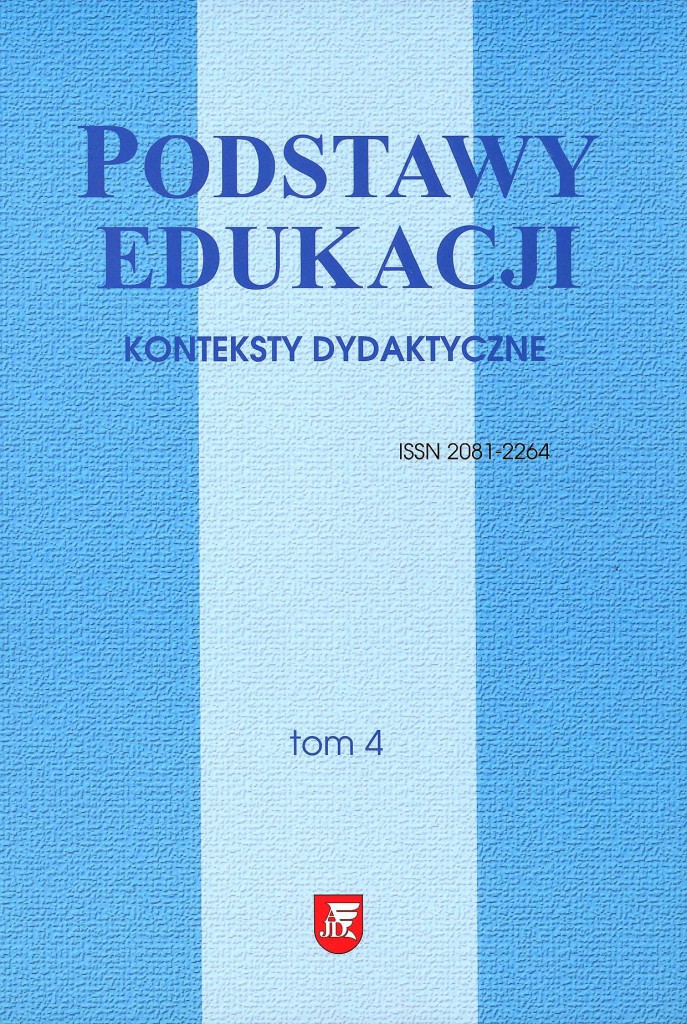Abstract
At the turn of the XX and XXI centuries we can observe a rapid development and expansion of so called new media. At present the term encompasses mainly computers and the Internet. These modern technology achievements have a crucial impact on nearly each sphere of human functioning, such as entertainment, work, communication or banking. Hence, education is also undoubtebly under their profound influence. Even if the general educational pedagogy did not deal with the new media at all not noticing their emergence in human life, it is undisputable that the quality of teaching and learning processes would change anyway. This fact results from easier access to information and a possibility of information exchange on an extremely large scale. Therefore, researchers’ attention is increasingly attracted to this phenomenon. Unfortunately, empirical and theoretical analyses conducted so far bring equivocal results. At the same time, the answer the question posed in the title of the present article depends to a great extent on our approach to the presence of the new media in education. The question concerns the nature of changes caused by the introduction of the new technological devices in the educational process. These changes may bring either radical and revolutionary quality alternations, or they may be gradual like in the case of evolution, or, finally, they may lead to regression caused by an improper approach to the problem concerning the relationship between the man and the new media – consequently we will witness the worsening of the quality of teaching and learning. The present article attempts to undertake such a discussion. The contemporary educational pedagogy is forced to deal with the teaching and learning computerisation process. It must describe this process and investigate potential possibilities, benefits and threats connected with the phenomenon. It should have the leading role in such research.
References
Berne, E. (1994). Seks i kochanie. J. Mikos (tłum.). Warszawa.
Berne, E. (1994). W co grają ludzie. P. Izdebski (tłum.). Warszawa.
Griffin, E. (2003). Podstawy komunikacji społecznej. O. i W. Kubińscy, M. Kacmajor (tłum.). Gdańsk.
Juszczyk, S., Zając, W. (1997). Komputerowa edukacja uczniów z zaburzeniami w czytaniu i pisaniu. Katowice.
Kotarbiński, T. (1957). Wybór pism. Warszawa.
Kupisiewicz, C. (1966). Nauczanie programowane. Warszawa.
Okoń, W. (1998). Wprowadzenie do dydaktyki ogólnej. Warszawa.
Reeves, B., Nass, C. (2000). Media i ludzie. H. Szczerkowska (tłum.). Warszawa.
Sadura, W. (1979). Funkcje powszechnej szkoły średniej a rola środków dydaktycznych. W: W. Sadura (red.). Funkcje i zasady stosowania środków dydaktycznych w nowoczesnej szkole. Warszawa.
Skłodowski, J. (1987). Video, mikrokomputer i szkoła nowoczesna. Ruch Pedagogiczny, 6.
Stoll, C. (1999). High Tech Heretic. Why Computers don’t Belong in the Classroom and Other Reflections by a Computer Contrarian. Nowy Jork.
Talarek, M. Czym właściwie są „nowe media”. http://twentynineninetynine.wordpress.com/2006/01/30/czym-wlasciwie-sa-nowe-media/.
Zaczyński, W.P. (1980). Proces dydaktyczny. Cele i zasady nauczania. W: M. Godlewski, S. Krawcewicz, J. Wołczyk, T. Wujek (red.). Pedagogika. Podręcznik akademicki. Warszawa.
Zaczyński, W.P. (1990). Uczenie się przez przeżywanie. Warszawa.
I am aware that the journal is published under the Creative Commons Attribution License (https://creativecommons.org/licenses/by/4.0/legalcode).
By submitting an article, I agree to make it available under this license.
